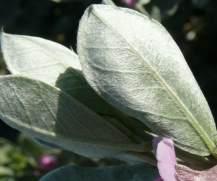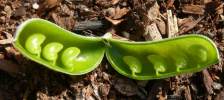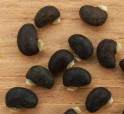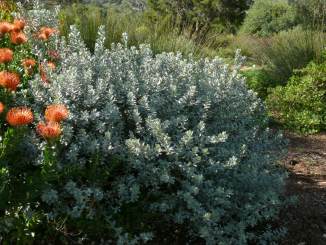Podalyria sericea
Podalyria sericea ( Andrews) R.Br. ex W.T.Aiton
Family: Fabaceae
Common names: silver sweet pea bush, silky podalyria, cape satin bush ( Eng. ); silwer keurtjie (Afr.)
Introduction
This silvery, rounded shrub has attractive, soft shiny leaves and small, pretty pink flowers in winter which are followed by unusual swollen seed pods.

Description
Description
Podalyria sericea is a small, naturally rounded, evergreen shrub, 1 x 1m. The lovely silky, silver-grey foliage gives the whole plant a silvery, shiny lustre.

Leaves are simple, with long straight close-pressed glossy hairs above and beneath. The leaves and seed pods are almost more attractive than the flowers. Single, small, pretty pink flowers are dotted all over the bush from May to August. Flowers are borne in the leaf axils and flower stalks are enclosed by the calyx. A characteristic of this family is that the flowers are typically pea-like: a large back petal (the standard), two smaller side petals (wings) and two lower petals that are fused to form a keel enclosing the stamens and pistil.

The flowers are followed by inflated pods, borne on the bushes from about October until January. The pods split to release several small seeds with a small fleshy appendage attached.


Conservation Status
Status
Podalyria sericea is listed as Vulnerable. This plant is threatened due to alien plant infestations, grazing and too frequent fires in its natural habitat.
Distribution and habitat
Distribution description
It occurs on sandstone and granite outcrops below 500 m from Saldanha Bay to the Cape Peninsula . It is also commonly found on sandy flats and hillsides. It does not tolerate frost and does best with winter rainfall.
Derivation of name and historical aspects
History
The genus Podalyria was named after Podalirius, the son of Asklepios, who was the Roman god of medicine. The specific name sericeus (Latin), means silky. It was David Nelson, a botanist who sailed with Captain Cook, who introduced this lovely plant to British gardens. This genus occurs in the large legume (Fabaceae) family which includes more than 700 species ranging from perennial herbs to dwarf shrubs and includes only a few trees.
Podalyria is a genus of 25 species, endemic to southern Africa, mainly occurring in southern Western Cape, extending into the Eastern Cape and KwaZulu-Natal. Common characteristics are simple, alternate leaves, and pink or white pea-like flowers. The other noteworthy species in this genus is P. calyptrata, the sweetpea bush, a 2-3 m well-branched shrub, with silvery foliage and sweet-scented mauve-pink flowers in spring.
Ecology
Ecology
Flowers are visited by carpenter bees and many other insects.
Uses
Use
This plant has much decorative horticultural value.

Growing Podalyria sericea
Grow
Podalyria sericea grows best in full sun, and prefers well-drained, well-composted, acidic loam soils. It is easy to grow and has a moderate growth rate. A good garden subject and water-wise once established, it does well combined with other drought tolerant plants. In mixed fynbos beds it is best grown in groups, planted close together for a mass effect where its silvery foliage provides a wonderful contrast against the green of the other shrubs. Used in a rock garden, it makes a striking specimen plant, or can be an unusual container plant.

In summer rainfall areas it must be watered well in autumn and winter. It does not thrive in alkaline soils. As it is from a frost-free climate, it does not tolerate frost, so it will need protection when grown in gardens where severe frost may occur.
As with most Fabaceae, growing Podalyria sericea is quite difficult from cuttings. It is best grown from seed sown in autumn or spring. Seeds germinate easily. Soaking seeds in hot water and treating with a fungicide that combats pre-and post-emergence damping off will increase the success of germination. Sow 1-2 mm deep in sandy, well-drained potting soil. Seed germinates in approximately two weeks. After germination, the seedlings should be potted up into individual bags/pots as soon as the first pair of true leaves appears, taking care to minimize root disturbance. Protect young plants from frost.
References
- Brown, N & Duncan, G. 2006. Grow fynbos plants. Kirstenbosch Gardening Series, Cape Town.
- Jackson, W.P.U. 1977. Wild flowers of Table Mountain, Howard Timmins, Cape Town.
- Leistner, O.A. (ed.). 2000. Seeds plants of southern Africa : families and genera. Strelitzia 10. National Botanical Institute, Pretoria.
- Lighton, C. 1973. Cape Floral Kingdom. Juta, Cape Town.
- Smith, C.A. 1966. Common names of South African plants. Memoirs of the Botanical Survey of South Africa No. 35.
Credits
Cherise Viljoen
Kirstenbosch Garden
September 2007
Plant Attributes:
Plant Type: Shrub
SA Distribution: Eastern Cape, Western Cape
Soil type: Sandy, Loam
Flowering season: Spring, Early Summer
PH: Acid, Neutral
Flower colour: Pink
Aspect: Full Sun
Gardening skill: Average
Special Features:
Horticultural zones







Rate this article
Article well written and informative
Rate this plant
Is this an interesting plant?
Login to add your Comment
Back to topNot registered yet? Click here to register.